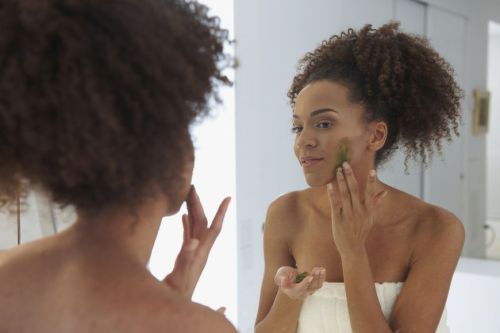Beauty 911: How to fix peeling skin asap!
When you get peeling skin from a sunburn, the winter dry-out, or a straight-up retinol, these are expert-approved tips for getting rid of it, fast.

Peeling skin knows no season. In the summer, you have to deal with it because lounging poolside often results in a scorched complexion by way of a sunburn. In the winter, skin often gets flaky because cold temps require your heater to work overtime. And straight up any time you start a retinol or tretinoin cream (which, it’s important to note, should usually be during the winter months due to sun-sensitivity concerns), you’ll have a period where your skin can only be described as molting. In other words, knowing how to get rid of peeling skin doesn’t just become a once-off kind of sitch: It’s 365-day job.
TBH, some of this is normal, textbook human bod stuff—it doesn’t necessarily indicate some sort of underlying skin condition. I recently came across the world’s most disgusting statistic: Over the course of a year, the average person can shed about one and a half pounds of skin. But when it’s excessive, it’s understandable why you’d want the flakes to go away right now, thank you very much. So to help shed light on the subject, I checked in with a dermatologist to see what’s up. Here’s what she had to say.
Keep scrolling for dermatologist-approved tips (and plenty of home remedies) for how to get rid of peeling skin.

1. Confirm it’s not caused by an underlying medical condition
Your skin is your largest organ, and so often when your body is trying to communicate with you, signs can be written on its surface. So before you go any further, confirm that you don’t have a chronic skin condition like eczema or psoriasis that could be causing your skin to peel. One way to do this is seek medical advice during your yearly skin check. In addition to having your dermatologist scope out any weird moles to be sure there’s no skin cancer lurking, bring a list of rough patches and/or question-mark spots to speak with them about as well.
2. Use a gentle exfoliant to remove dead skin
Cool, so you know that the skin peels you’re dealing with are as a result of your environmental exposures. Reach for an ultra-gentle exfoliator like the Peet Rivko Exfoliator ($34), which lifts dead skin cells with a combo of jojoba beads, rice bran, and oatmeal. When you’re dealing with peeling skin, the pros recommend one with a physical grain versus one with a chemical agent like alpha-hydroxy acid or beta-hydroxy acid because you’re able to better control them. (Speaking as an AHA aficionado, I can attest: Getting acid on baby-new skin can burn). Apply light pressure as you move around your complexion in circular motions to lift away peeling skin.
This Parisian Skincare Brand Is Launching in the United States for the First Time—Here’s What a Derm Wants You to Know

We’re Calling It: Cleansing Balms Are the Face Wash of the Future—Here Are 3 to Add to Your Cart

This Is the One Product That Scarlett Johansson Always Keeps in Her Purse and on Her Bedside Table

3. Immediately rehydrate you skin
Once you’ve cleaned and exfoliated, resist the urge to pick at the loose skin. “The desire may be to peel it off,” says Danbury, Connecticut-based dermatologist Mona Gohara.
But if you ignore her warnings: “Make sure you rehydrate…because that’s your skin barrier in your hand.” Start by taking a cool bath (hot water likely won’t feel so good, and may wind up further drying out the skin), then seal in the moisture with some lotion. Because the skin barrier has been compromised, you want to look for ingredients like ceramides and lipids that are pretty much a fix-it crew for your skin in this SOS moment. In addition to repairing skin, they also create an occlusive barrier, which keeps the water in your skin from evaporating and making the sitch worse. If you’re dealing with a sunburn, anti-inflammatories like aloe vera gel or cortisone cream can help calm the discomfort and stop peeling from getting worse.
4. And then keep rehydrating throughout the day
5. Add a humidifier for good measure to keep skin moist
You tend to think of the dry months as a time to add in a humidifier, but truth: air conditioners work by sucking the humidity out of the air to chill it out—that’s why window units often drip water. So humidifiers are just as important in the humid months to put moisture back in to the air in your home. Since you’re going to keep this puppy on all 12 months, consider investing in the Dyson Humidifer ($499) which comes with a hefty price tag, but also a built-in UV system to kill the bacteria in the moisture-spiked air (many humidifiers are a breeding ground for the stuff). “Intense hydration both through moisturization and humidification is essential,” Dr. Gohara tells me. So stay diligent and know: This too shall pass.
Originally published on July 18, 2018; updated February 25, 2020.
So now you know how to deal with peeling skin, but this is how to exfoliate in a super-gentle manner and these are the skin-saving ingredients from Australia that you really need to know about now.
Sign Up for Our Daily Newsletter
Get all the latest in wellness, trends, food, fitness, beauty, and more delivered right to your inbox.
Got it, you've been added to our email list.







